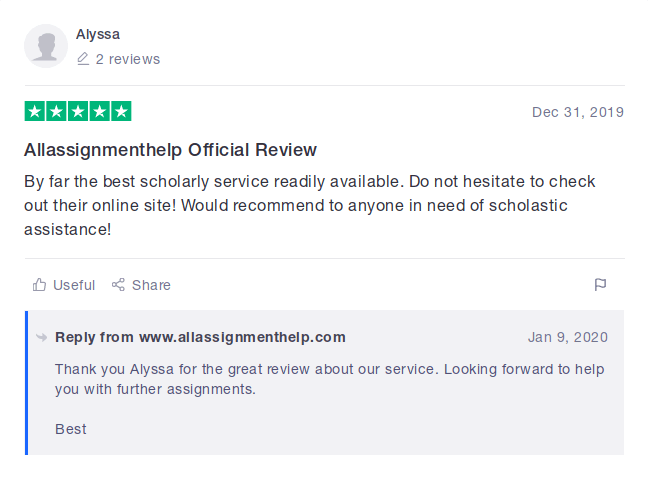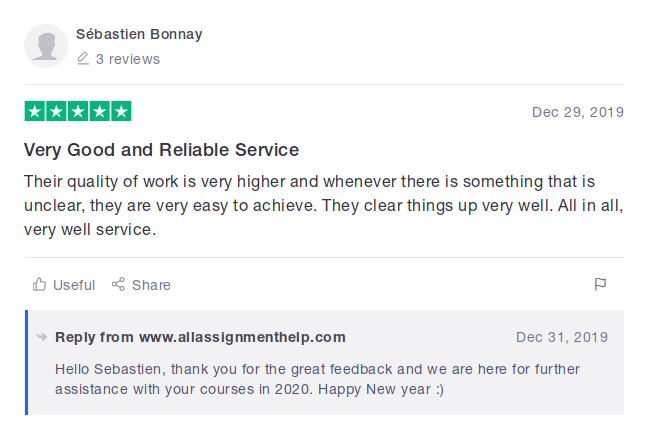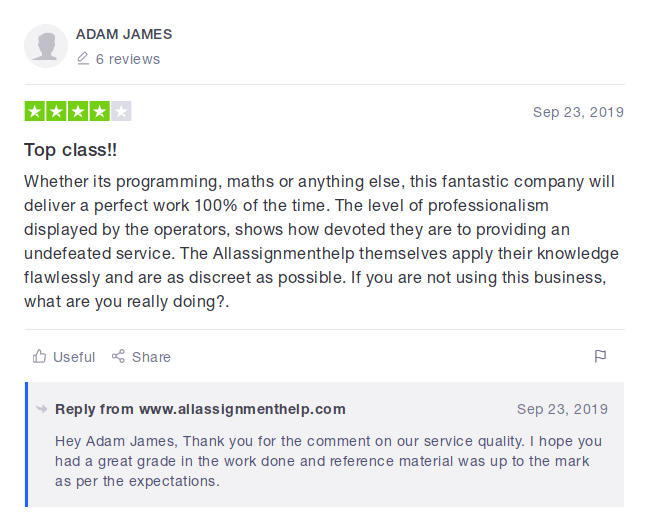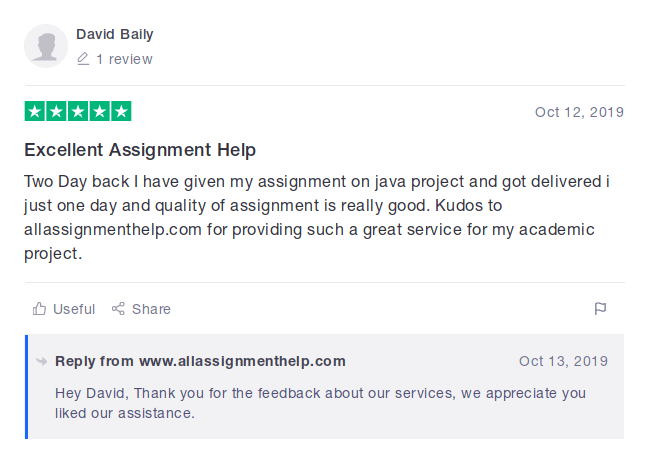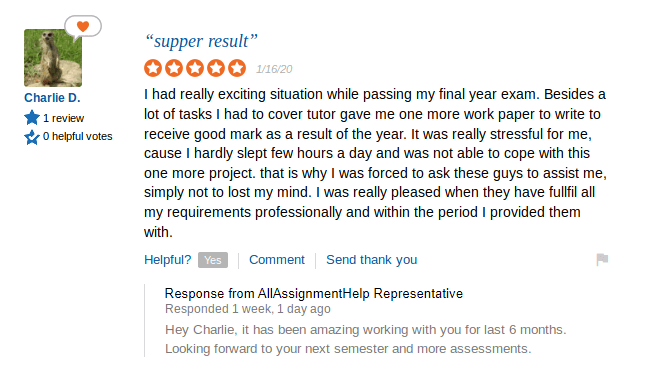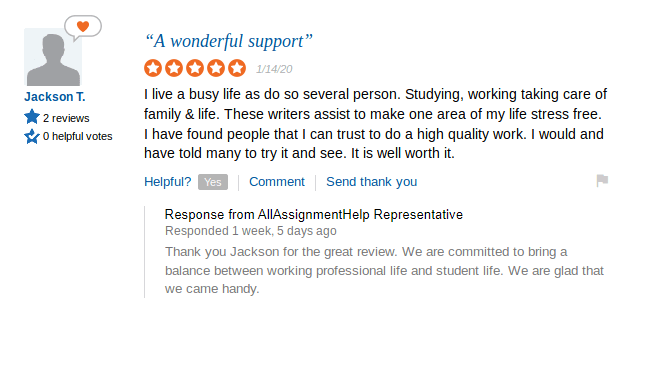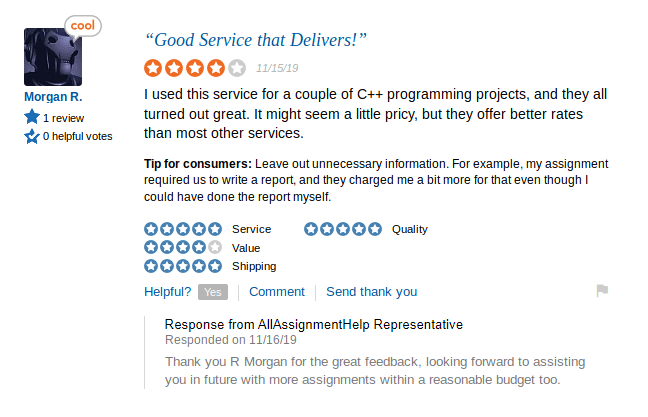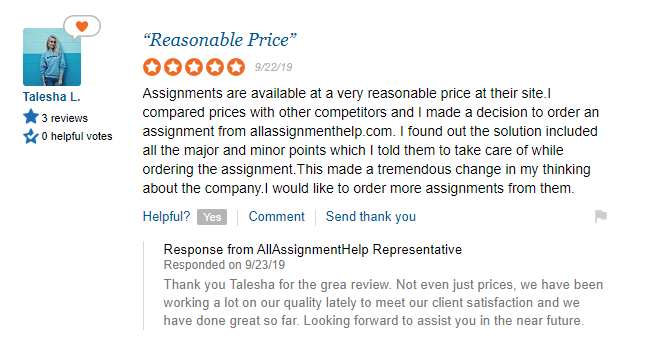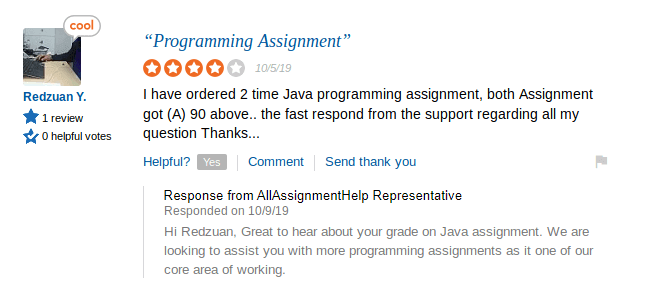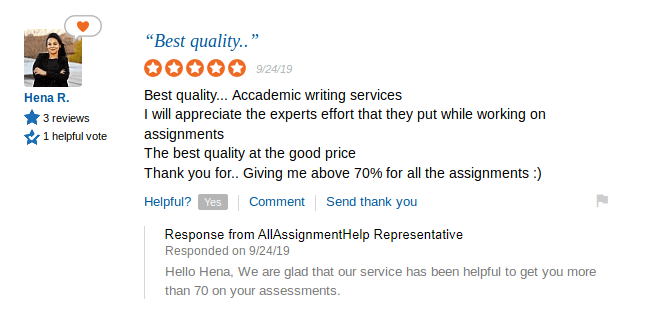Why students order last minute assistance with assignments from us
You have the flexibility to chose an assignment expert that suits your budget and quality parameters. We have more than 2000 PhD experts available to assist with assignments.
-
Order Preview Before Final Work
You get a preview before making final payment.
-
Pay Using different channels
You can pay using multiple secure channels, such as PayPal or Credit Cards.
-
Plagiarism Free Work Guaranteed
We sent unique content with no plagiarism.
-
Ping Us On Live Chat
You can talk to us anytime around the clock. We are up for the support.
-
Choose Your Own Expert
We let you chose from the pool of 2000 PhDs tutors.
-
Go Mobile
You do not need to be on laptop all the time, our mobile interface is great to use.
Reviews and Trust Go Hand In Hand
Allassignmenthelp.com has garnered nothing but praise from the clients. Any trustworthy review platform has positive review about our service and gives us motivation to improve.
Claim Your Offer
30% OFF & 150% Cashback on your First order !
Type your whatsapp number to get an exclusive code.
Recent Completed Projects
You can look at some of the samples that we did recently, we strongly recommend not to use samples for writing your assignment.
You are just a click away from getting the best assignment help service
Don't worry anymore as we are here for you.
Place Your OrderExecutive summary of the case
There was a continuing dispute between Microsoft and Samsung which continued for almost six months. The dispute was over the royalty payments that Samsung owed to Microsoft for using its patented technology in its Android-based handsets and tablets as agreed by both the parties by entering into an Android patent licensing agreement in 2011. It was found that Samsung had not made the royalty payment for 2013 to Microsoft and also the interest was not paid. On this Microsoft had sued Samsung on account of breach of contract. On the other hand, Samsung pleaded that it was mentioned in the agreement that no party could do any business collaboration with the competitors and since Microsoft had acquired Nokia’ business, Microsoft had also become a direct competitor to Samsung. Hence, Samsung considered it as a breach of the agreement and thereby claimed that it was not liable to make any further payments of royalty to Microsoft. The case is now finally settled by the court and Samsung has been asked to make the royalty payments to Microsoft. Now further in this paper, we have discussed the main issue pertaining to the case, the legal principles, and rules that were applied to the case and on the basis of these we have analyzed the case and finally have concluded the case.
Issue
Microsoft had filed a suit against Samsung where it claimed that Samsung (that is a Korean Electronics Manufacturer of mobile handsets and tablets) had breached the intellectual property contract that was signed between the two companies in 2011. It was agreed by Samsung in the contract of 2011 that it will be paying Microsoft an amount every year towards the royalty payment for using the Microsoft technology in its Android products. Samsung made the timely payment for the first year, and it did not pay anything for 2013. It was found that it had stopped making any further payments to Microsoft. It was claimed by Microsoft that Samsung owed to it around $ 6.9 million as interest payment which was in association with the deal.
"If you are on a lookout for superb assignment writing services, Allassignmenthelp UAE is where you can stop. Their services are affordable to students. I am a literature student, and I found them best in every essay assignment I ordered from them. From formatting to content quality, everything was perfect."
Tahir Said,
Fujairah
It had been alleged by Microsoft that at present it has around 200 patents which are being used in the Androids-based devices and also that the company has always been very active in finding its various hardware manufacturers, which includes its partners in order to make payments for royalties for using its Androids which are generally based on the intellectual claims. It had also been alleged by the Microsoft in the court that around 80% of the Android-Based Smartphones that are sold and used all over the United States have been licensed to use its patents("Forbes Welcome," n.d.).
It had been contended by Microsoft that as per the terms of the license agreement signed in between Microsoft and Samsung in 2011, Samsung had agreed to make the payment of royalty towards Microsoft for a period of seven continuous fiscal years as Samsung was using the patented Microsoft technology while making its devices such as smartphones and tablets which involved the use of Android operating systems.
It was claimed by Microsoft in its complaint that Samsung has clearly failed in making its payments of royalty on time for two years and had also failed to pay the interest accrued on account of not making the royalty payments on time. It was argued by Microsoft that Samsung owed to it an interest also in excess of the amount of $6.9 million on account of its late Android-patent fee. It had been alleged that till the date of filing of this case, Samsung had not made the payments due with respect to royalty for using patents. The amount of payment towards royalty for using patented technology as agreed between Microsoft and Samsung was kept undisclosed. But due to a filing of this case, it came in the light. It was found that the total payments that were due which Samsung owed to Microsoft for as royalty using the Android patent technology were calculated as $ 1 billion which was found through an unsealed document as on August 29, 2013.
The main question in the case roams around the Intellectual property agreement that was signed between Microsoft and Samsung which was to be continued for several years for the payment of royalties for using patented technology of Microsoft for its Android phones. It was found that both the companies Microsoft and Samsung had agreed for cross-licensing their intellectual property for which Samsung owed royalty payment to Microsoft("Microsoft vs. Samsung, Explained - InformationWeek", n.d.). It was also found in October 2014 that the royalty payment by Samsung to Microsoft was agreed at $ 1 billion for only a single year and where it was alleged that Samsung had not paid the royalties for 2013. Thus, Microsoft claimed that Samsung had breached the contract of intellectual property licensing by not making the agreed payments.
Place Order For A Top Grade Assignment Now
We have some amazing discount offers running for the students
Place Your OrderOn the other hand, the defendant, Samsung also claimed that by acquiring the Nokia handsets, Microsoft has also breached the part of the agreement which talked about business collaboration as was agreed between the two companies. Samsung has filed counterclaims against Microsoft where it contended the licensing agreement and the terms contained therein which was related to the business collaboration agreement. It was argued by Samsung that both the companies through the agreement had agreed to cross-license their patents and also to collaborate on development and marketing of the windows- based devices including the smartphones and tablets, but this agreement was breached by Microsoft when it went ahead with the acquisition of Nokia.
Microsoft had announced it publically that it was planning to acquire Nokia’s devices and also its service businesses (Lim, 2015). Nokia was considered to be the biggest competitor of Samsung. Samsung also alleged that the Microsoft was not allowed as per the terms of the agreement to enter any agreement with the competitors, but it violated this when it entered into an agreement with Nokia.
After all the dispute taken to the U.S courts and the (International Chamber of Commerce) arbitration, the companies finally came to a joint decision to resolve the matter and for this, they had issued a joint statement by publishing it on their respective blogs. They both had announced that they had settled their dispute through the U.S court.
Rule
The law provides that patent is an intangible asset which provides the owner with an exclusive right where he can forbid any other person from using its technology which has been patented by him in anywhere in the country which has issued that patent for a definite term for which the patent is being issued. If someone infringes this right then the patent holder has the right to sue for monetary damages or even for an imprisonment for violating his patent rights. But if patent holder wants to share its patented technology with someone and wants to allow him to use it for a fixed time period then the patent holder has the option of licensing its patent in favor of that person.
License for the patents may be granted in different ways, that is, it can be either an exclusive license or a non-exclusive license. But these licenses may have certain limitations with respect to its time and territories. Also, a license may cover either the use of the complete patented technology or can be for the use of some particular component or improvement in the technology (Armstrong, 2014).
And in respect of this patent license, the licensee makes the payment of royalty to the patent holder. Thus, it can be said that a royalty payment is considered as a payment which is made by the licensee or franchisee to the licensor or franchisor in exchange for using the asset that is exclusively owned by the licensor or franchisor. Royalties are generally calculated as some fixed percentage of the revenues that are gained by the licensee from using the asset of the licensor or it can also be fixed as a definite price per unit of that item which is sold in the market. There are also various modes and metrics of compensation. A royalty interest can be understood as a right where the licensor is allowed to collect a series of future royalty payments (Krumholz, 2015).
Place Order For A Top Grade Assignment Now
We have some amazing discount offers running for the students
Place Your OrderPatents are licensed by entering into a patent license agreement, and it serves as a means to settle any dispute that may arise in future with respect to infringement of patent rights. As a general rule, these agreements provide for the terms of the agreement which covers the governing of all further disputes for patent infringement that may arise in future among the parties to the agreement. If the licensee even after the inclusion of such terms in the contract breaches the agreement in such a way that directly or indirectly leads to the license standing terminated, then in such a situation the licensor is allowed as per law to file a legal suit against the licensee for the infringement of the patent(Neurology, 2014)
Also, it has been provided by the law that in the case of infringement of the patent or patent license the court may allow for "reasonable royalties” in favor or the aggrieved party which it can impose anytime that is either after the fact or prospectively or even both as a remedy for the infringement.
Also sometimes court determines an injunction order to be the most appropriate remedy in the lawsuits involving patent infringement. If this situation arises where the court deems that injunction order is the most appropriate remedy then in such a case, the court may award an alternative remedy in the form of “ongoing royalties” or royalties on the basis of the prospective use by the infringer of the patented technology.
The same situation like our current case was also found in a very famous case of Rydex v. Graco, Inc. The case was filed in the court and involved the claim for the breach of contract and infringement of patent between the concerned two parties, that is, Rydex and Graco. It was also established by the evidence and facts of the case that both the parties had also settled previously a similar case of dispute by entering into a license patent agreement. But now again the parties were confronting the same issue, and it was told to the court that Graco has stopped making the royalty payments in favor of Rydex for which Rydex had sued Graco again. As the counter attack, Graco claimed that he had stopped the royalty payments as Rydex had failed to undertake his obligations under the agreement that they had signed("Licensee's Breach of Agreement Provides Licensor with Ability to Sue Licensee for Infringement | Articles | Finnegan", n.d.). It was also alleged by Graco that whatever dispute the parties were facing must be controlled by the license agreement as it contained a term which talked about the redressal of the dispute between the parties in future over patent infringement issues. He alleged that even when he had stopped the payment and had breached the agreement, still it must be controlled by the agreement itself as the agreement barred all the patent infringement claims raised by Rydex against Graco in future also. Also, Graco had claimed that the license agreements have the ability to resolve even the claims that are related to any past infringement barred by all the future claims for the patent infringement, but other than the breach of the agreement.
After considering the allegations made by both the parties and also looking into the facts and evidence of the case, the court finally gave it opinion where it disagreed with the claims made by Graco and found that Graco's arguments were in contradiction to the express language that was used in the agreement. It was thus, concluded by the court that an agreement which provided for the resolving of any past disputes was only limited to the resolution of past disputes
This case serves as a means to remind the licensees and licensors about the utmost importance that they must give while expressing the language to be used in the agreements that are entered into between the two parties and also to the inclusion of the terms related to the breach of the agreement by the parties. And in this sense, it cannot bind a party to an exclusive remedy by the terms of the contract even if the opposite party has breached the agreement.
Note: This is not a complete solution. You can request the complete solution by filling out the order form towards your requested assignment.
Place Order For A Top Grade Assignment Now
We have some amazing discount offers running for the students
Place Your OrderREFERENCES
Afiouni, F., 2007. Human resource management and knowledge management: a road map for improving organizational performance. Journal of American Academy of Business, 11(2), pp.124-130.
Conklin, J., Anderson, L.W., Krathwohl, D., Airasian, P., Cruikshank, K.A., Mayer, R.E., Pintrich, P., Raths, J. and Wittrock, M.C., 2005. A Taxonomy for Learning, Teaching, and Assessing: A Revision of Bloom's Taxonomy of Educational Objectives Complete Edition.
Doorewaard, H. and Benschop, Y., 2003. HRM and organizational change: an emotional endeavor. Journal of organizational change management, 16(3), pp.272-286.
Hislop, D., 2003. Linking human resource management and knowledge management via commitment: A review and research agenda. Employee relations, 25(2), pp.182-202.
Liao, Y.S., 2005. Business strategy and performance: The role of human resource management control. Personnel Review, 34(3), pp.294-309.
 +1-817-968-5551
+1-817-968-5551 +61-488-839-671
+61-488-839-671 +44-7480-542904
+44-7480-542904


